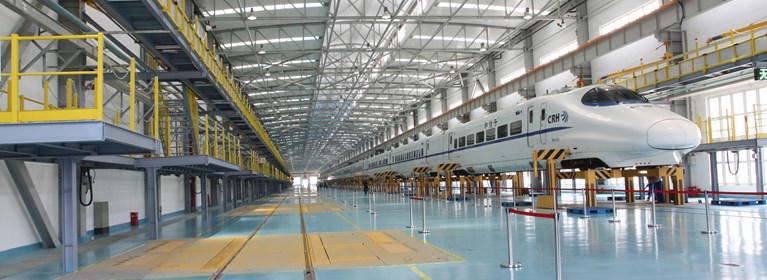Automated Electrostatic Painting System
Manufacturing |
Power & Motion Technology |
By Magnetek |
Oct 19, 2005
Background
A tractor-trailer manufacturer’s trailers were rusting after a couple of years on the road. It was determined that normal road debris hitting the trailers was chipping the paint. When the paint was chipped it allowed moisture and salt to penetrate to the steel, thus causing rust. A more durable paint finish on the trailers was needed for better protection against chipping. The solution was to provide a fully automatic, electro-static paint, dip tank system. This method of painting provides a stronger, more even paint finish and eliminates the need for a crew of painters to manually paint the trailers.
System Description
The system consists of three identical cranes, each working over a separate tank line. The cranes vary only in the control program being run in its on-board Allen-Bradley SLC 5/04 PLC. Parts move between cranes on a conveyor system.
The cranes have rigid fixed masts for their hoists. Each crane’s hoist is controlled by an Electromotive IMPULSE®•VG+ Series 2 drive. The bridge is controlled by an Electromotive IMPULSE®•G+ Series 2 drive. Each crane has a tilt mechanism that is controlled by two Electromotive IMPULSE®•G+ Series 2 drives. All three cranes communicate with an off-board Allen-Bradley PLC 5/20C mounted in a console enclosure. This PLC is responsible for traffic control, interfacing to the conveyer and tank control systems, and communicating with the Allen-Bradley PanelView 1400 operator interface.
System Operation
Main operation of the crane is automatic. An SBP2 pendant is used for manual back-up. The conveyor feeds a trailer from the shot booth to the Pre-coat Tank Line. Crane #1 removes the trailer from the conveyor and moves it through the Pre-coat Tank line using a predetermined recipe. The tilt mechanism is used to allow the liquid from each tank to run off before the part is put in the next tank. After Crane #1 is finished, the part is placed on the conveyor and taken to the Base Coat Tank Line. Crane #2 removes the trailer and takes it through the Base Coat Tank Line using a predetermined recipe. This is where the first electro-static painting is completed. After Crane #2 is finished, the part is again placed on the conveyor and is taken to the oven for curing. When the part is removed from the oven, the conveyor takes it to the Top Coat Tank Line. Crane #3 then removes the part from the conveyor and takes it through the Top Coat Tank Line. This is where the second electro-static painting is completed. After Crane #3 puts the part on the conveyor, it is taken through a second oven for curing. The part is then moved out of the second oven and is once again processed through to the Top Coat Tank Line. The trailer is then placed in the first tank for cooling before moving out of the system.
Related Products
SBP2®
Pushbutton Stations
By: Magnetek
North America - EN





